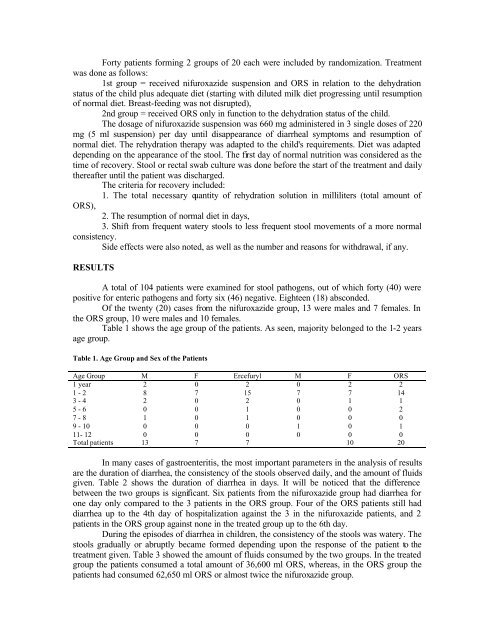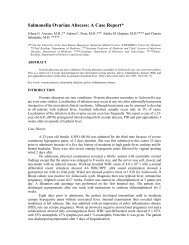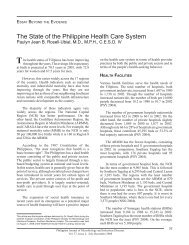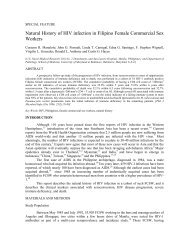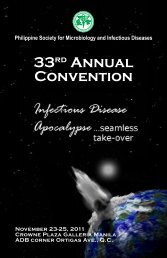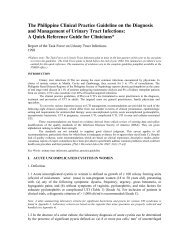Nifuroxazide (Ercefuryl) Plus Oral rehydration solution Versus Oral ...
Nifuroxazide (Ercefuryl) Plus Oral rehydration solution Versus Oral ...
Nifuroxazide (Ercefuryl) Plus Oral rehydration solution Versus Oral ...
You also want an ePaper? Increase the reach of your titles
YUMPU automatically turns print PDFs into web optimized ePapers that Google loves.
Forty patients forming 2 groups of 20 each were included by randomization. Treatment<br />
was done as follows:<br />
1st group = received nifuroxazide suspension and ORS in relation to the dehydration<br />
status of the child plus adequate diet (starting with diluted milk diet progressing until resumption<br />
of normal diet. Breast-feeding was not disrupted),<br />
2nd group = received ORS only in function to the dehydration status of the child.<br />
The dosage of nifuroxazide suspension was 660 mg administered in 3 single doses of 220<br />
mg (5 ml suspension) per day until disappearance of diarrheal symptoms and resumption of<br />
normal diet. The <strong>rehydration</strong> therapy was adapted to the child's requirements. Diet was adapted<br />
depending on the appearance of the stool. The first day of normal nutrition was considered as the<br />
time of recovery. Stool or rectal swab culture was done before the start of the treatment and daily<br />
thereafter until the patient was discharged.<br />
The criteria for recovery included:<br />
1. The total necessary quantity of <strong>rehydration</strong> <strong>solution</strong> in milliliters (total amount of<br />
ORS),<br />
2. The resumption of normal diet in days,<br />
3. Shift from frequent watery stools to less frequent stool movements of a more normal<br />
consistency.<br />
Side effects were also noted, as well as the number and reasons for withdrawal, if any.<br />
RESULTS<br />
A total of 104 patients were examined for stool pathogens, out of which forty (40) were<br />
positive for enteric pathogens and forty six (46) negative. Eighteen (18) absconded.<br />
Of the twenty (20) cases from the nifuroxazide group, 13 were males and 7 females. In<br />
the ORS group, 10 were males and 10 females.<br />
Table 1 shows the age group of the patients. As seen, majority belonged to the 1-2 years<br />
age group.<br />
Table 1. Age Group and Sex of the Patients<br />
Age Group M F <strong>Ercefuryl</strong> M F ORS<br />
1 year 2 0 2 0 2 2<br />
1 - 2 8 7 15 7 7 14<br />
3 - 4 2 0 2 0 1 1<br />
5 - 6 0 0 1 0 0 2<br />
7 - 8 1 0 1 0 0 0<br />
9 - 10 0 0 0 1 0 1<br />
11- 12 0 0 0 0 0 0<br />
Total patients 13 7 7 10 20<br />
In many cases of gastroenteritis, the most important parameters in the analysis of results<br />
are the duration of diarrhea, the consistency of the stools observed daily, and the amount of fluids<br />
given. Table 2 shows the duration of diarrhea in days. It will be noticed that the difference<br />
between the two groups is significant. Six patients from the nifuroxazide group had diarrhea for<br />
one day only compared to the 3 patients in the ORS group. Four of the ORS patients still had<br />
diarrhea up to the 4th day of hospitalization against the 3 in the nifuroxazide patients, and 2<br />
patients in the ORS group against none in the treated group up to the 6th day.<br />
During the episodes of diarrhea in children, the consistency of the stools was watery. The<br />
stools gradually or abruptly became formed depending upon the response of the patient to the<br />
treatment given. Table 3 showed the amount of fluids consumed by the two groups. In the treated<br />
group the patients consumed a total amount of 36,600 ml ORS, whereas, in the ORS group the<br />
patients had consumed 62,650 ml ORS or almost twice the nifuroxazide group.


